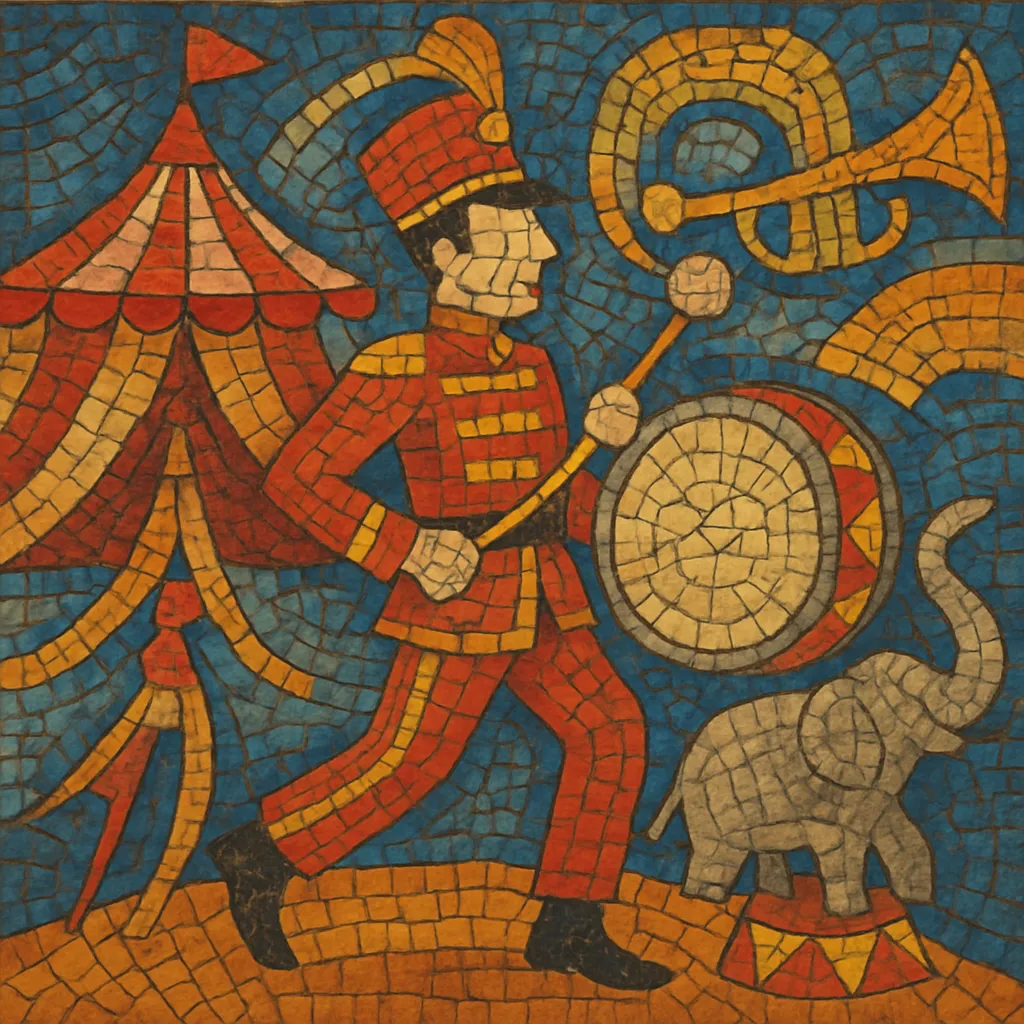
Circus march (often called a "screamer") is a very fast, brilliant style of American march written to accompany circus parades, act changes, and aerial or animal features under the big top.
It emphasizes dazzling woodwind runs, blazing brass fanfares, and driving percussion at tempos commonly between 160 and 200 BPM, creating high excitement and clear cues for performers.
Typical forms mirror American march conventions—intro, two strains, trio (often in the subdominant), and a dramatic breakstrain (dogfight)—but with greater virtuosity, brighter orchestration, and sharper dynamic contrasts. The sound is closely associated with calliopes and band organs that broadcast these pieces beyond the tent and through circus grounds.
Circus march emerged in the United States during the late 1800s as traveling circuses grew into large, elaborately staged spectacles. Bands had to project outdoors, cue acts precisely, and keep audiences energized between ring changes. The American march tradition provided the structural template, while the circus environment demanded faster tempos, brighter tone colors, and more virtuosic writing.
By the 1890s and early 1900s, specialist composers and bandleaders—often working directly for major circuses—began producing “screamers,” a term reflecting their intense brilliance and speed. Pieces like Julius Fučík’s Entry of the Gladiators (1897)—popularized in the U.S. as a circus staple—set the archetype heard on calliopes and band organs. Composers such as Karl L. King, Henry Fillmore, Russell Alexander, Fred Jewell, and Charles E. Duble supplied a steady stream of works tailored to the needs of specific acts, entrances, and parades.
As large circuses (notably Ringling Bros. and Barnum & Bailey) standardized production values, the circus march vocabulary coalesced around blistering tempos, brilliant woodwind passagework, high brass fanfares, and emphatic percussion. Bandleaders like Merle Evans codified performance practices from 1919 onward, and publishers/arrangers (e.g., Mayhew L. Lake) disseminated parts for both live bands and mechanical band organs, spreading the style far beyond circus lots.
While the number of large touring circuses declined, the circus march’s sound became a cultural shorthand for clowning, spectacle, and kinetic action—pervasive in school marching bands, pep bands, and media depictions of the circus. Today, these marches persist in band repertoires, heritage performances, and recordings of historic calliope and band-organ rolls, and they continue to influence high-energy band writing and crowd-rouser arrangements.
Write for a traditional wind band core: cornets/trumpets, trombones (use smears and glissandi tastefully), horns, euphoniums, tubas; piccolos/flutes (feature rapid, brilliant runs), clarinets/saxophones for agility and harmonic fill; percussion (snare, bass drum, crash cymbals) driving a relentless two-step. Consider calliope or band-organ timbres if arranging for mechanical instruments or evoking the classic circus ambience.
Use 2/4 or cut time at a bright 160–200 BPM. Keep the rhythmic engine clear and buoyant—snare-drum rolls and accents lock with tuba oom–pah figures. Favor crisp articulations, short notes in accompaniments, and sparkling scalar/arp passages in upper winds.
Follow march architecture: a short intro; first strain (A) and second strain (B) with memorable, buoyant melodies; a trio (C) modulating to the subdominant (e.g., Bb to Eb) with smoother, more cantabile lines and lighter percussion; then a breakstrain (dogfight) contrasting antiphonal low brass and upper winds; final trio reprise with countermelodies and a “stinger” chord to close. Use diatonic harmonies with occasional secondary dominants and chromatic passing tones—clarity and momentum are paramount.
Spotlight piccolos/clarinets for rapid figurations, trumpets for brilliant fanfares, and low brass for dogfight power. Employ sudden dynamic swells, crisp accents, and brief modulations for excitement. Keep textures transparent so countermelodies and obligatos read over the drive.

